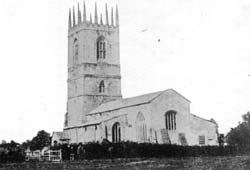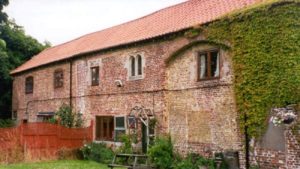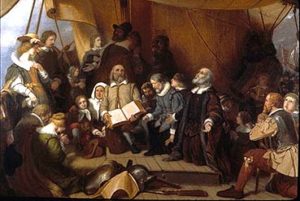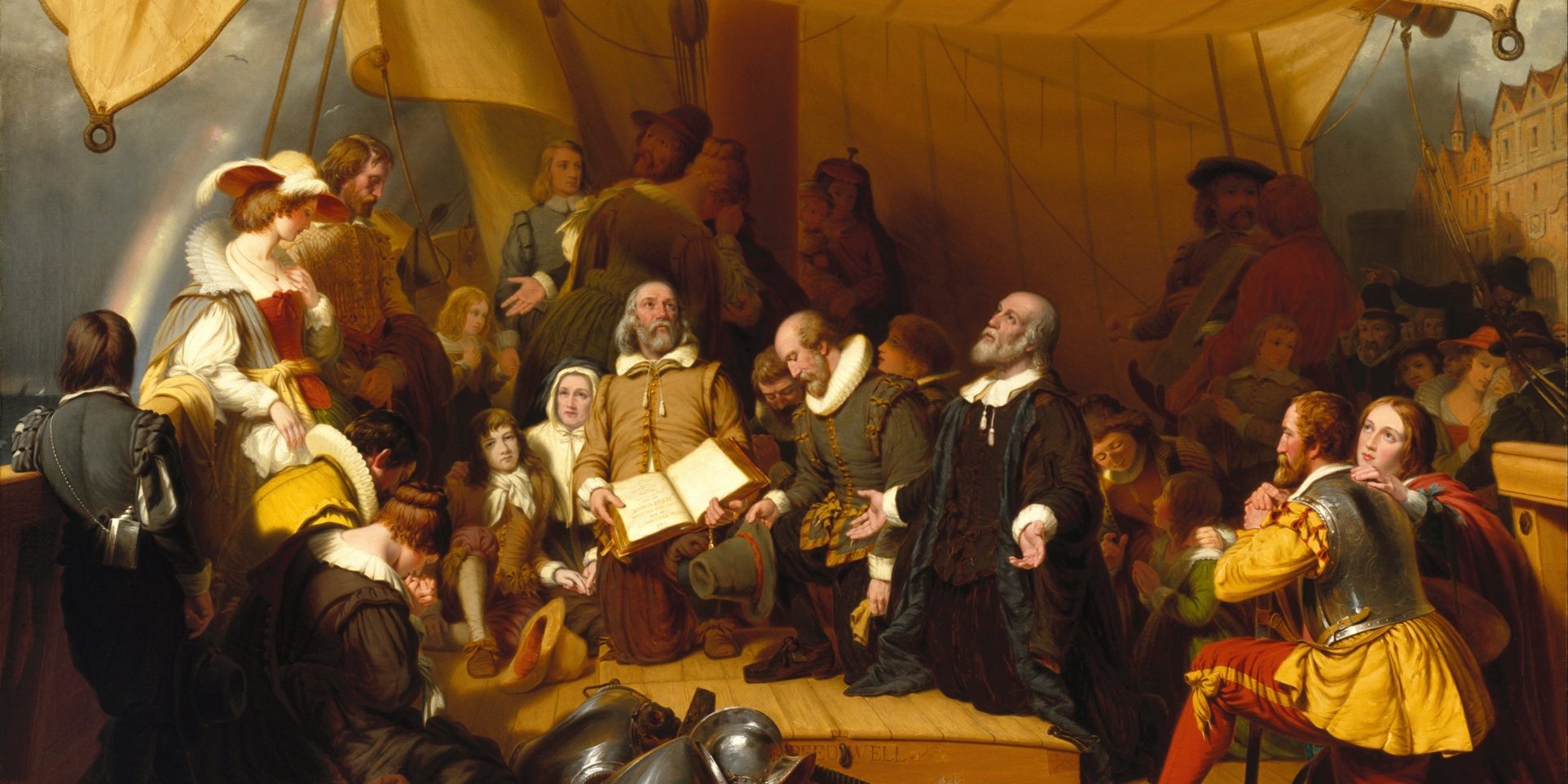 The Pilgrim story is a church migration project and much of its success is due to the instructions and leadership of Pastor John Robinson. The Pilgrims landed in what is now Provincetown in early November of 1620. Their first response was to fall on their knees and to bless the God of heaven. One month later they landed on Plymouth Rock and as stepping stones, built a society on biblical law, principles and conduct. Only a remnant of the Leyden congregation came to America.
The Pilgrim story is a church migration project and much of its success is due to the instructions and leadership of Pastor John Robinson. The Pilgrims landed in what is now Provincetown in early November of 1620. Their first response was to fall on their knees and to bless the God of heaven. One month later they landed on Plymouth Rock and as stepping stones, built a society on biblical law, principles and conduct. Only a remnant of the Leyden congregation came to America.
John Robinson’s influence is even more important to highlight, particularly because he did not come with them to the new world. Much to the credit of their pastor and the able leadership of Robinson’s good friend William Brewster, they were able to function as a church and state. The unique ideas on life, liberty of conscience and toleration of those who differed with them live on as their legacy. After all, the influence of a Pastor is not necessarily what is done while he is alive, but how influential his followers are to carry forth those ideas in subsequent generations.
 Who was John Robinson? He was born between March and September of 1575 in the town of Sturton Le Steeple, named for its church spire. He was raised by his parents to love the Geneva Bible, which was small enough to carry, cheap enough to own, and organized enough for personal study. It was truly the “Bible of hearth and home.” Bible reading in the home was the golden thread of the great revival of the Reformation. The family became, as the Puritans called it, “a little church and Commonwealth.”
Who was John Robinson? He was born between March and September of 1575 in the town of Sturton Le Steeple, named for its church spire. He was raised by his parents to love the Geneva Bible, which was small enough to carry, cheap enough to own, and organized enough for personal study. It was truly the “Bible of hearth and home.” Bible reading in the home was the golden thread of the great revival of the Reformation. The family became, as the Puritans called it, “a little church and Commonwealth.”
With such a heritage, it is no wonder that Robinson was sent to Cambridge University to continue his studies, for it was a “seedbed” for Reformation thinking. He embraced the rigor of rising at 5 AM, being tutored in Latin, Greek and Hebrew, attending lectures and debates, and learning the art of rhetoric and philosophy. He embraced the fact that theology was the “queen of the sciences,” or the heart of all the other disciplines – like the hub of a wheel. He also learned to appreciate the unique contributions of Peter Ramus (1515-1572), whose logic rested on Scripture in contrast with Aristotle. As a lifetime pursuit, he truly embraced Scrutamini Scripturas (search the Scriptures) in keeping with the focus of the Reformation – Sola Scriptura – the Scripture alone the standard for life and conduct!
Why was Pastor John Robinson’s influence on the Pilgrims so unique? The most powerful influence any of us have on others is our example. Our character speaks louder than our words. How John Robinson dealt with separating from the established Church, restoring a biblical definition for the true Church, and dealing with controversy peacefully paved the way for those we know as Pilgrims to do the same. In 1604 John Robinson resigned his position at Cambridge (he had stayed on to tutor younger students), got married to Bridget White, and took the pastorate of St. Andrews, an established Church of England Church under the control of the Bishop.
However his conclusion that he must resign his position as Pastor would impact the Pilgrim Church. “St. Andrews is not a people separated and sanctified from the world into holy covenant with God… (She) hath not the liberty either to engage any minister… or to remove any… but at the will of the Bishop.” This rejection of top-down, centralized control in the church would be the basis for rejecting the same tyranny in the state. Robinson’s theology was an extension of John Calvin and William Ames. The Pilgrims, through Robinson, became the inseparable link between Calvin’s theology and America’s liberty – all based on the character necessary for maintaining self-government as taught in the Bible.
 When the Pilgrim Church regathered under Robinson’s leadership in 1606 at Scrooby Manor, the residence of William Brewster, they did so by a clear and voluntary covenant of the people. “So many there… as saw the evil these things… and whose hearts the Lord had touched with heavenly zeal for His truth; they shook off this yoke of antichristian bondage; and as the Lord’s free people; joined themselves (by a covenant of the Lord) into a church estate, in the fellowship of the gospel to walk in all his ways… whatsoever it should cost them.” Every American ought to be thankful they were willing to pay such a price for their beliefs!
When the Pilgrim Church regathered under Robinson’s leadership in 1606 at Scrooby Manor, the residence of William Brewster, they did so by a clear and voluntary covenant of the people. “So many there… as saw the evil these things… and whose hearts the Lord had touched with heavenly zeal for His truth; they shook off this yoke of antichristian bondage; and as the Lord’s free people; joined themselves (by a covenant of the Lord) into a church estate, in the fellowship of the gospel to walk in all his ways… whatsoever it should cost them.” Every American ought to be thankful they were willing to pay such a price for their beliefs!
The influence of John Robinson was his powerful example of biblical peacemaking, especially with those who differed and persecuted them. He saw the danger of forming an identity on what you opposed rather than living for Christ. To avoid unnecessary conflict, he moved his church from Amsterdam to Leyden. Writing of their time in Leyden, Bradford relates, “Being thus settled (after many difficulties) they continued many years, in a comfortable situation; enjoying much sweet, and delightful society, and spiritual comfort together in the ways of God; under the able ministry, and prudent government of Mr. John Robinson, and Mr. William Brewster, who was an assistant unto him in the place of an Elder.”
 What was John Robinson’s legacy? Robinson led his church to make peace with God through confession of sin and receiving forgiveness. He also taught them to maintain peace with one another by humbly working to find common ground. He further taught them to function as a commonwealth, voting for people based on their character rather than mere appearance and rhetoric. At their departure from Holland he urged them to, “Follow me no further than you follow Christ,” and to make the Scriptures the ultimate standard. His personal legacy was to send William Brewster in his place. On the deck of the Speedwell we see both Brewster and Robinson in prayer before the church left Leyden in the famous painting which hangs in Pilgrim Hall Museum in Plymouth and the Rotunda in Washington D.C.
What was John Robinson’s legacy? Robinson led his church to make peace with God through confession of sin and receiving forgiveness. He also taught them to maintain peace with one another by humbly working to find common ground. He further taught them to function as a commonwealth, voting for people based on their character rather than mere appearance and rhetoric. At their departure from Holland he urged them to, “Follow me no further than you follow Christ,” and to make the Scriptures the ultimate standard. His personal legacy was to send William Brewster in his place. On the deck of the Speedwell we see both Brewster and Robinson in prayer before the church left Leyden in the famous painting which hangs in Pilgrim Hall Museum in Plymouth and the Rotunda in Washington D.C.
John Robinson died in 1625 at only 50 years of age. His wife Bridget died sometime after 1640. Of their eight children, three died in England before turning 50 and four died in Holland. Their fifth child, Isaac, came to America, and we know that he kept the legacy of his father. In Massachusetts, he opposed the mistreatment of Quakers in Falmouth and joined with the revival on Martha’s Vineyard among the Native Americans (where his house still stands.) He died in Barnstable in 1704. Both father and son’s views on family, church and state would become in some measure the foundation of American culture. No wonder Bradford said these words about John Robinson:
“…For besides his singular abilities in divine things (wherein he excelled) he was also very able to give directions in civil affairs, and to foresee dangers, and inconveniences; by which means he was very helpful to their outward estates, and so was every way as a common father unto them… such was the mutual love and reciprocal respect that this worthy man had to his flock, and his flock to him… it was hard to judge whether he delighted more in having such a people, or they in having such a pastor.”







